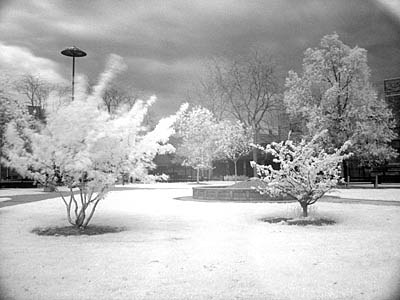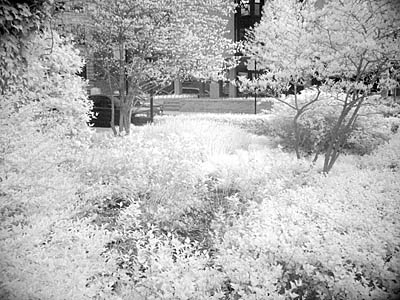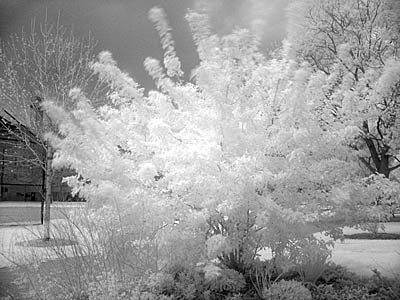
I always had thought that the bright white appearance of foliage in the near infrared was due to chlorophyll fluorescence--indeed, in a college class on plant structure and function, I recall examining a large beaker filled with chlorophyll dissolved in some alcohol, illuminated with a strong beam of light, that was deep red when viewed to the side.
You can see a spectrum of various vegetation here. Note how strongly plants begin to reflect at 700nm, which is near the far-red limit of vision. (You can see light beyond 800nm, if it's bright enough, but that's another post of OSHA violations and laser regs).
However, this remote sensing page shows that the high albedo of plants in the near infrared is actually just due to the cellular structure of the leaf. Plant structures are essentially transparent in the near-infrared, and the light is efficiently scattered in the air spaces beyond the first layer of cells. This has been compared to the mechanism that causes snow to be so white and reflective for a substance that is made up of transparent pieces. Newer leaves are not as thick and full of air gaps as mature leaves, and so should reflect less. The spongy mesophyll (what a great term, in my opinion), this interior area, allows for proper interchange of gases, and access to it is controlled by the stomata. Here is a (large) photomicrograph of a leaf cross-section: http://koning.ecsu.ctstateu.edu/Plants_Human/images/leafcslabel.jpg
http://www.storm.uni.edu/rs/2001/vh3.html
I took most of these photos over a month ago, when Chicago was experiencing spring, so the trees had small leaves. In many cases, the wind is blowing the trees around and ruining the multi-second exposures!


4 comments:
Hi,
How did you get your Powershot A95 to take IR photos?
I describe the filter here: Infrared Gallery. In short, I use two or three layers of fully exposed and developed color negative film, placed in front of the lens.
Also see a hosta leaf in the near-IR
Muito bom parabéns
Post a Comment